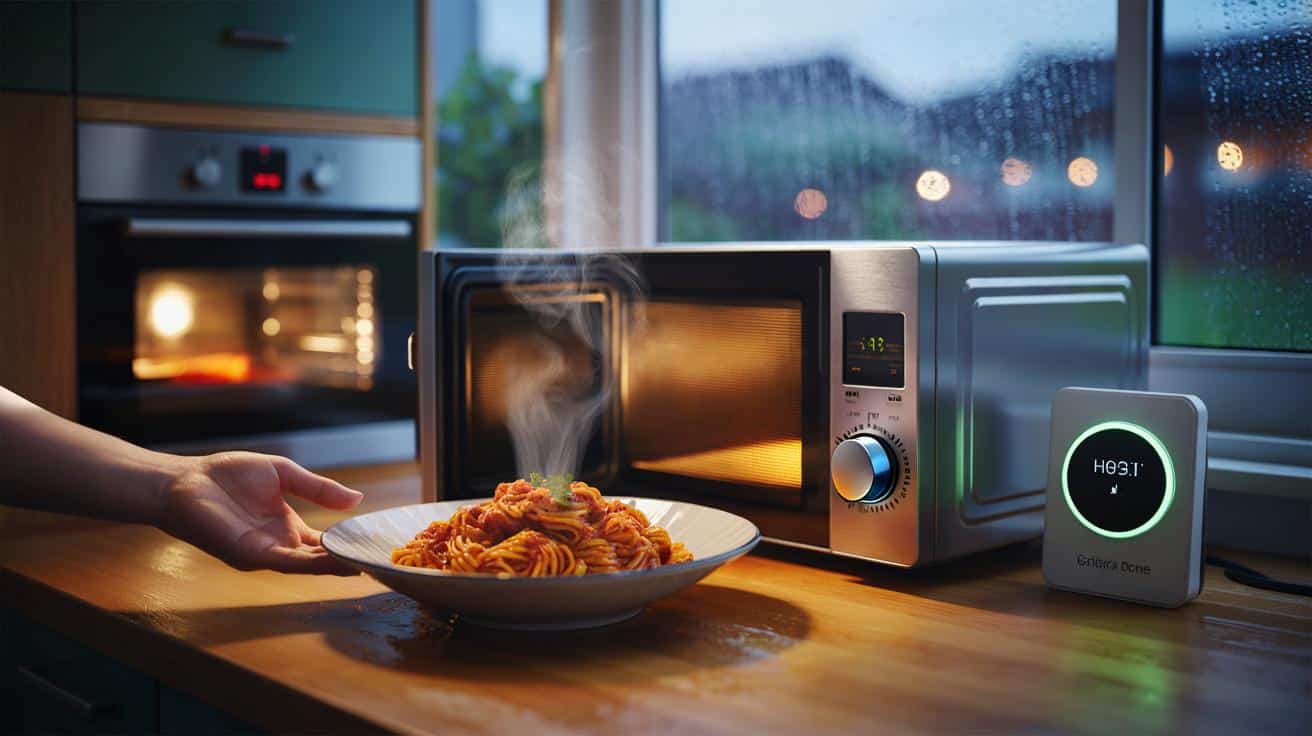The kitchen glows, the fan roars, and the bills creep up. Your microwave, sitting there humming quietly, might actually be the cheaper, faster answer.
The rain had just started when I got home, the type that needles the evening and fogs the streetlights. I flicked on the oven out of habit, then glanced at the smart meter on the counter. The numbers leapt like a heartbeat. My daughter asked for pasta. The dog thumped his tail. I slid a bowl of leftover ragù into the microwave and hit 800W for four minutes. The meter dial settled back down, calm as a lake. We ate before the oven even finished preheating, and the room never turned into a sauna. We’ve all had that moment when the day asks for dinner, not drama. The meter made a different kind of argument.
The real cost hiding in your weeknight heat
Microwaves heat the water molecules in your food. Ovens heat the air, the metal, the walls, and then—eventually—the food. That gap matters. Every minute an oven spends preheating is energy with no flavour attached. A microwave delivers heat where it counts, which often **saves more than you think**.
Look at rough numbers on a typical UK tariff, around 28–30p per kWh. A 900W microwave running for 10 minutes uses about 0.15 kWh, so roughly 4–5p. An electric oven at 2.2–2.8 kW for 40–50 minutes can burn 1.5–2 kWh, or 45–60p. Warm a curry? The microwave wins. Bake a tray of chips for one? You pay for the air, not the potatoes. Over a month of weeknights, that gap becomes a dinner-sized saving.
It isn’t just power rating; it’s time on task. Microwaves often cut cook time by half or more because they aim heat at the food’s core. Ovens excel at browning and drying surfaces, which is gorgeous for roast chicken, wasteful for reheating last night’s chilli. If the goal is “hot and tasty soon,” the microwave carries less baggage. And less bill.
Microwave tactics that turn cheap heat into good dinners
Think layers: cover, power, pause. Cover food with a vented lid or plate to trap steam and keep edges moist. Use 50–70% power for thicker items so heat penetrates without overcooking the rim. Build in a rest of one to three minutes; the heat equalises, and flavours settle. That pause is quiet magic.
*Yes, you can get real flavour from a microwave.* Toss veg with oil, salt and a tiny splash of water, cover, then cook in short bursts with a stir between. Finish under a hot grill for 2–3 minutes if you want colour. Jacket potato? Ten minutes in the microwave, then five in the oven or air fryer for the skin. Let’s be honest: nobody really does that every day. But when you do, it sings.
Small tweaks change everything.
Cook to temperature, not habit. The microwave is a heat source, not a compromise.
Use shallow, wider dishes to avoid tall cold centres. Stir or rotate halfway on dense foods like stew or leftovers thicker than a thumb. And remember, **time is money**.
- Use 30–50% power for even heat in meats and bakes.
- Cover and vent to keep steam working for you.
- Rest after cooking to smooth hot and cold spots.
- Finish under the grill for crackle and browning.
How to switch mindsets without losing dinner joy
Start by moving just one step each night into the microwave. Preheat less, finish more. Warm sauces and sides in the microwave while the oven handles a single crisping task. Build a **microwave-first mindset** where the oven becomes a finisher, not the main act.
Common missteps? Using bowls too deep, skipping a stir, blasting at 100% because it feels “faster.” Be kind to yourself. Shorter bursts and power levels feel fiddly on day one, then become muscle memory. Plastic tubs warp and leach smells; glass or ceramic solves that. Covering with a plate beats cling film. If a dish looks pallid, two minutes under the grill wakes it up. It’s not cheating; it’s smart heat.
Economy is a chain of small choices. Batch-cook base carbs in the microwave—rice, potatoes, couscous—then remix through the week with quick sauces. Microwave steam greens while pasta boils on the hob. Poach salmon at 50% power, then paint with miso and grill. You spend pennies, not pounds, and dinner stays weeknight-light. And when the bills come, the meter tells a quieter story.
Where this leaves your weeknights
The microwave doesn’t replace your oven’s theatre, and it shouldn’t try. It offers a different kind of relief—less noise on the meter, less heat in the room, less waiting while hunger taps its foot. Swap heat sources based on what the food needs first, not what the recipe assumes.
A roast still earns its Sunday. The weeknight asks for speed and sense. If the goal is hot, balanced, and good enough to share, the microwave carries a lot of dinner for a little money. The trick is noticing how often you’re paying to warm up the kitchen rather than the meal.
What you do next is the fun bit. Try a three-minute side of garlicky greens. Reheat pastas and stews in shallow bowls with a covered rest. Crisp as a finale, not a beginning. Your future self—standing over a quieter smart meter—might just thank you.
| Key points | Detail | Reader Interest |
|---|---|---|
| Microwave targets the food | Heats water molecules directly, reducing wasted ambient heat | Explains the “why” behind lower bills |
| Small time, small cost | Typical 10-minute blast uses pennies, not dozens of pence | Immediate savings you can feel this month |
| Finish for flavour | Grill or pan-finish brings colour without full oven time | Keeps texture and pleasure while cutting cost |
FAQ :
- Is a microwave really cheaper to run than an oven?For many weeknight tasks, yes. Short bursts at 800–1000W often cost only a few pence, while ovens run longer and heat the air as well as the food.
- Can I get crispy results without the oven?Use the microwave to cook through, then finish under a hot grill or in an air fryer for 2–5 minutes. A crisper tray helps for small items.
- Does microwave cooking reduce nutrients?Often the opposite. Shorter times and less water can preserve vitamins that are lost in long boiling or roasting.
- What containers should I use?Glass or ceramic with a vented cover works best. Avoid metal and flimsy plastics. Shallow dishes heat more evenly.
- How do I estimate the cost of a dish?Multiply power (kW) by time (hours) to get kWh, then by your tariff. Example: 0.9 kW × 0.17 h ≈ 0.15 kWh; at ~30p/kWh that’s about 4–5p.








